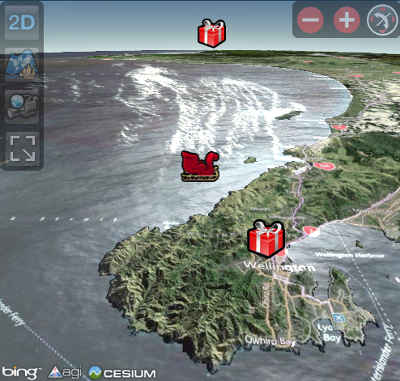| Norad To Track Santa With WebGL - IE Users Left Out |
| Written by David Conrad | |||
| Tuesday, 04 December 2012 | |||
|
Every year Norad uses its radar to track the progress of Santa so that children everywhere can know where their presents are. This year the operation goes even more high tech with the use of WebGL to create a 3D location map. The only problem is that IE users can't view the page because IE doesn't support WebGL. So instead of a 3D lollipop, IE users get a blank screen cinder from Santa.
Well OK, not a blank screen, the app falls back to a 2D map display on IE but this isn't exactly the Christmas magic you might have hoped for. To view Santa's track in glorious 3D you need a WebGL supporting browser and for desktop users this means installing Chrome or Firefox. The 3D visualization of Santa's location uses the Cesium open source virtual globe which is built on top of WebGL. There are some simulations available on the Cesium site but of course as the blog says: The locations used in the screenshots are based on test data; we, of course, won’t know Santa’s route until NORAD starts tracking Santa on Christmas Eve. In other words the app goes live on December 24th. The blog is also very clear about the reasons for using WebGL and the requirements for viewing the graphics: WebGL is available on most modern browsers, including Chrome and Firefox, and on all major desktop operating systems: Windows, Linux, and Mac. It doesn't explicitly say that if you are using IE you can't play in 3D but it does provide upgrade instructions to Chrome or Firefox. The rest of the blog entry gives a lot of technical detail on how Santa's location is plotted with great accuracy using a geo-tile server provided by Bing Maps which is of course Microsoft's mapping facility. What is even stranger is that Microsoft is credited with being a member of the Norad Tracks Santa Team. So Microsoft is providing the mapping but, due to the choice of 3D technology, its browser cannot be used in this mode.
The stars, in the views that include space, are rendered using data from NASA and there are a lot of additional features used in this showcase for Cesium. A 2.5D "flat earth" representation can be used instead of the full sphere and full screen mode can be used to get an uninterrupted view on the day itself. So if you see the graphs of Firefox and Chrome usage jump in the days after Christmas - now you know the reason. The choice of WebGL has delivered a very pleasing Christmas present to both Mozilla and Google. Ho, ho, ho..... IE The Browser You Loved To Hate A Browser For Work and Another For Play To be informed about new articles on I Programmer, install the I Programmer Toolbar, subscribe to the RSS feed, follow us on, Twitter, Facebook, Google+ or Linkedin, or sign up for our weekly newsletter.
Comments
or email your comment to: comments@i-programmer.info
|
|||
| Last Updated ( Wednesday, 05 December 2012 ) |



